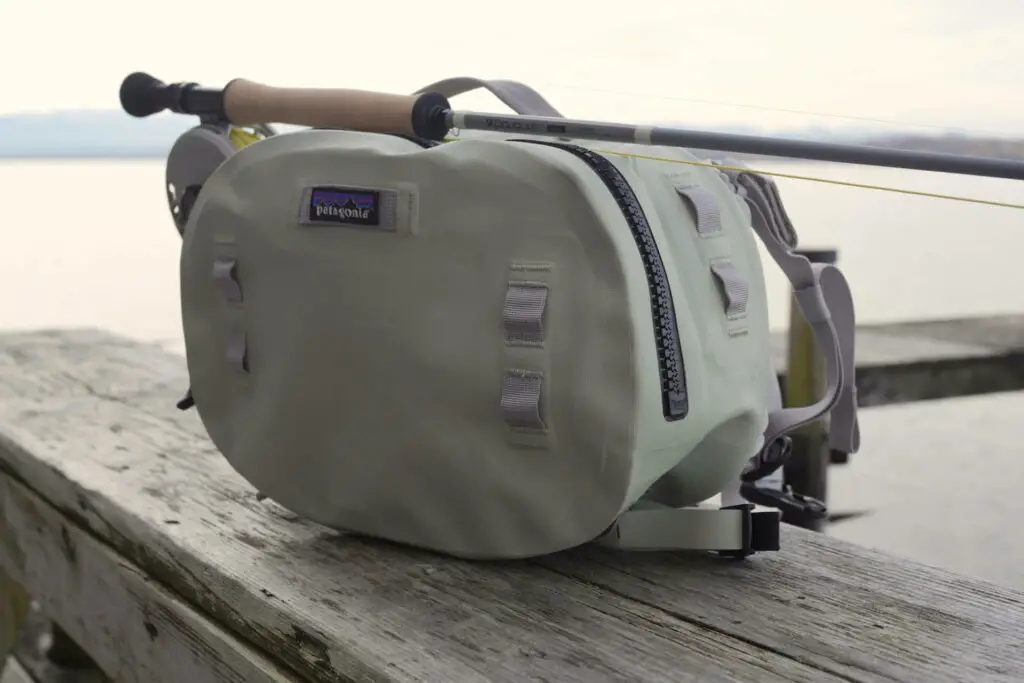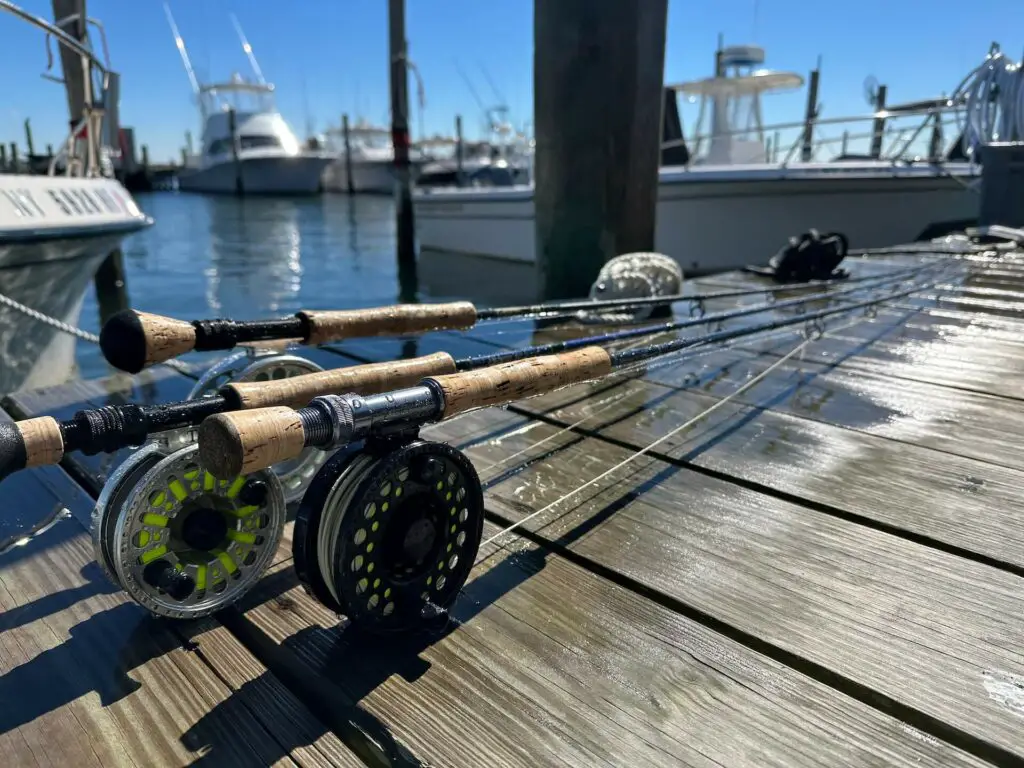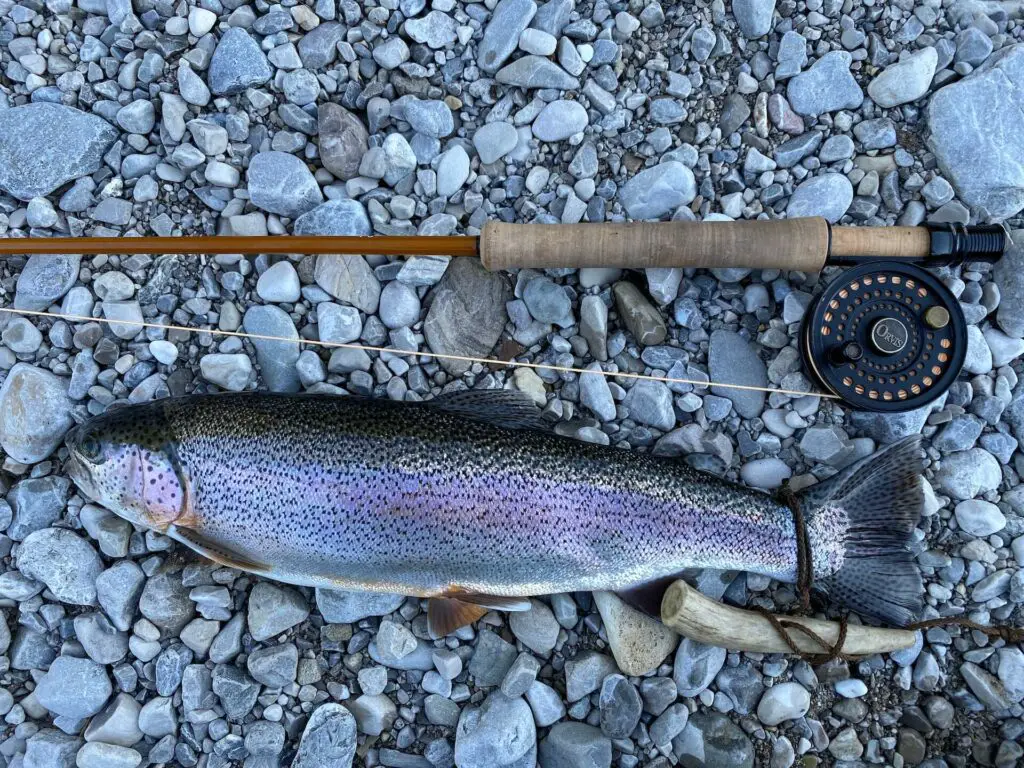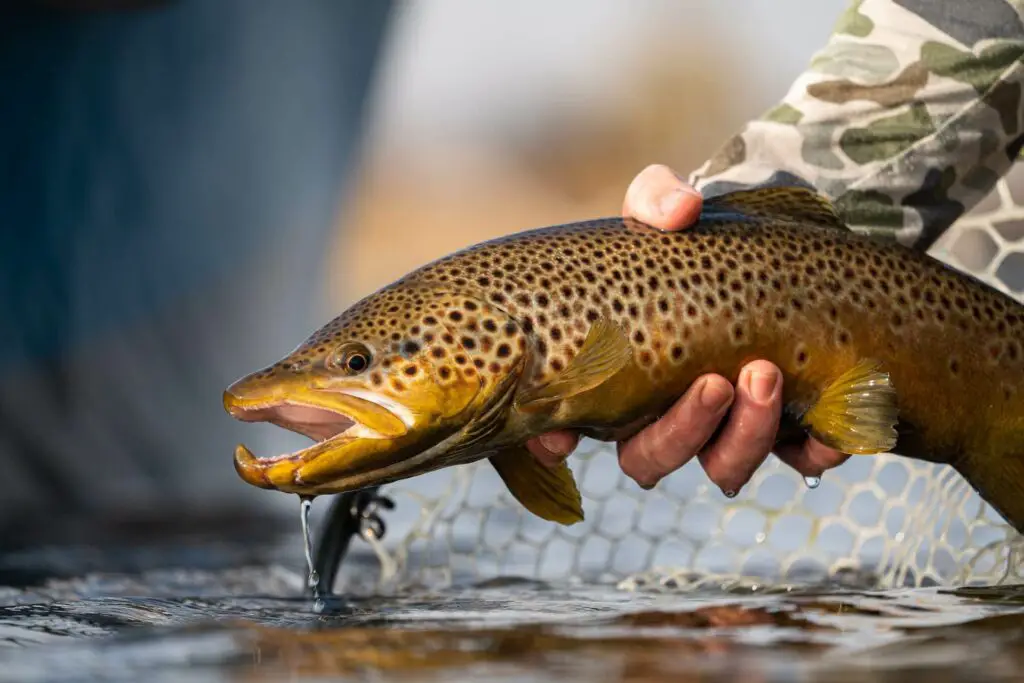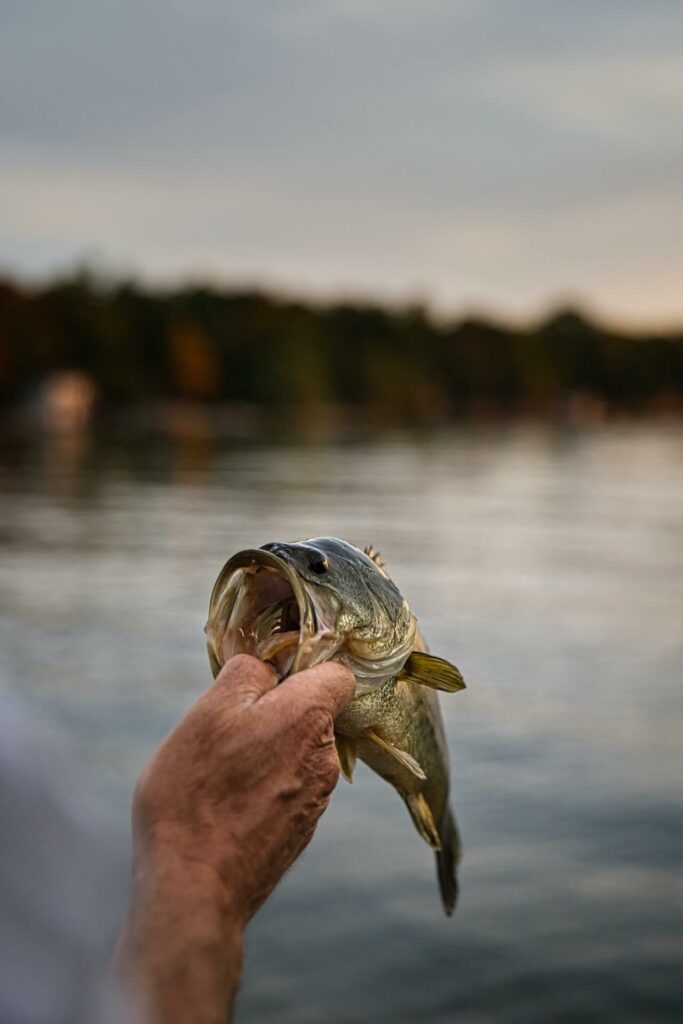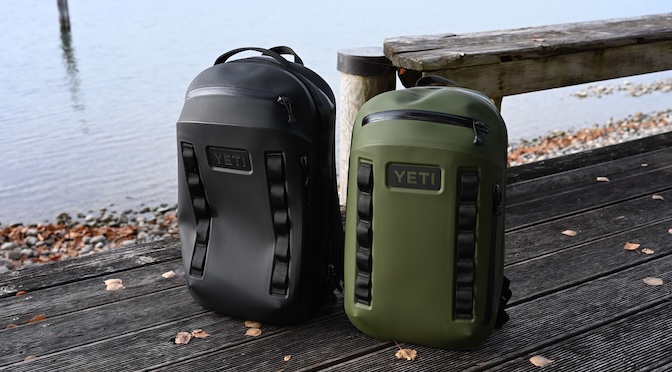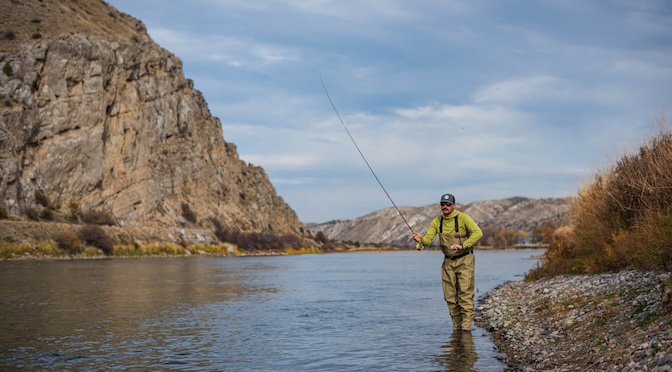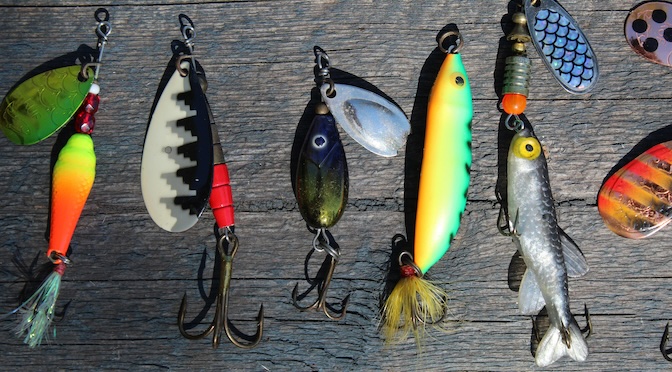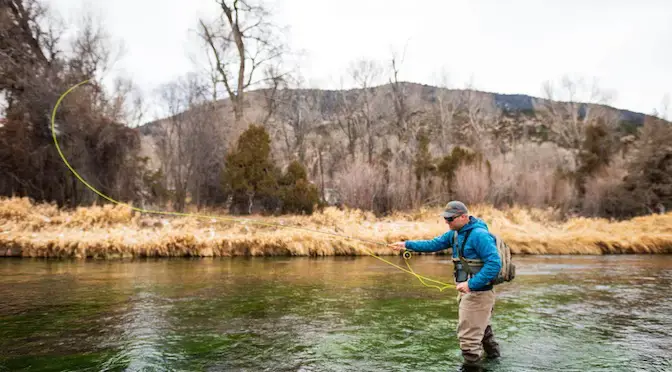Last updated on September 5th, 2025.
- Can YETI’s new backpack deliver? Thoughts on the YETI CAYO - November 20, 2025
- How to Put a Worm on a Hook: Proven Methods for a Perfect Bait - November 18, 2025
- How to Fish in a River: An Essential Guide to Proven Techniques - November 18, 2025
Are you a beginner fly fisherman looking for the best rod to get started with?
With so many options out there, it can be overwhelming to decide which one is right for you. Whether it’s weight class, rod length or action that matters most in your decision-making process – we’ve got you covered. Here are some tips on how to choose the best beginner fly rod of 2025 and which species of fish will give you an optimal experience when starting out. Read on as we dive into each topic and help make your choice easier than ever before.
Best Fly Rod for Beginners – Top Editor Picks for 2025:
-
Best Overall: Orvis Encounter
-
Runner Up: Douglas Guide
-
Best Looks: Redington Classic Trout
-
Best Action: Douglas Outdoors Era
-
Best Fly Rod Combo: Redington Original
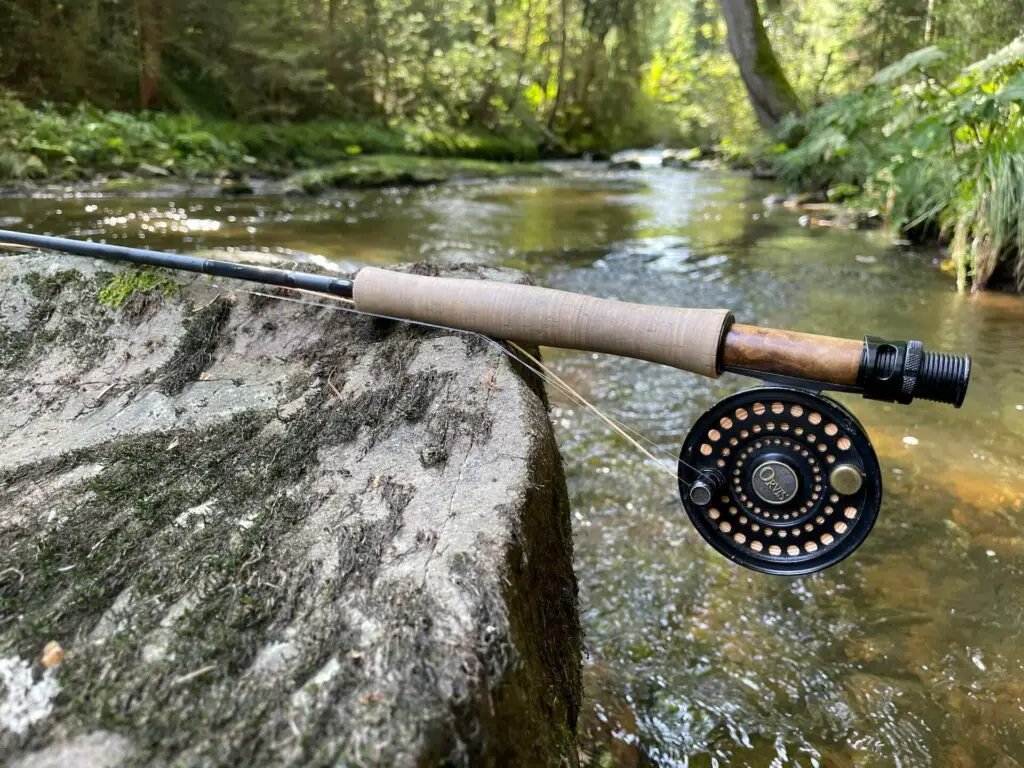
How We Test
Amongst our team we get to test and fish dozens of fly rods each year. All big manufacturers like Hardy, Sage, Orvis, Douglas, Guideline and Co. send us their gear to test and review. This makes sure we’re not preferring any particular brand but give our honest review on each product. Our team consists of highly experienced anglers with years of experience. We’re not rod builders but we’ve fished so many rods over the years that we claim to be able to tell a good rod from a bad one.
All of the rods in this guide are 5wt rods as that’s the gold standard for most people when they start fly fishing. The #5 is the classic trout rod and will get you far in the beginning.
Best Fly Rod for Beginners 2025
In this first part of the review we’ll be looking at the best beginner fly fishing rods. In the second part of the article we’ll check out the best beginner fly rods combos. A combo has the advantage that fly rod and reel are ideally balanced as they are picked by experts to form a set. Some fly rod and reel combos even include a fly line and leader. All you have to do is tie on a fly and you’re ready to catch your first fish. Now let’s jump right in and check out the best beginner fly fishing rods on the market in 2025.
Best Overall: Orvis Encounter
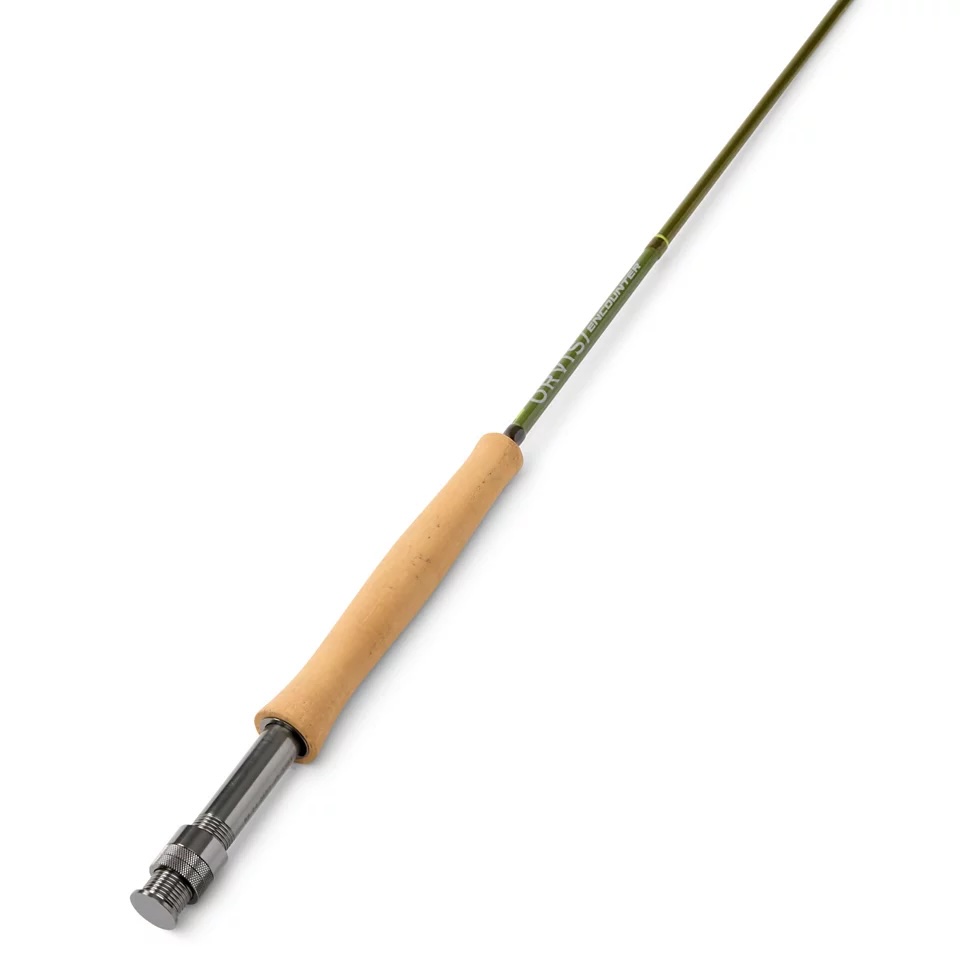
Key Features:
– Lightweight design, durable construction materials, comfortable grip handle and reliable performance overall.
– Great Orvis Warranty
– Available as a fly rid combo
After years of fishing higher-end rods, I picked up this Orvis entry-level setup out of curiosity, and I’ve got to say — the Encounter (read our full review here) is a solid piece of gear for the price. Orvis has such a long tradition of building premium rods and reels, and you can feel some of that trickle-down quality in this one.
The high-modulus graphite blank has a nice medium-fast action that makes casting easy and surprisingly accurate, even if you’re just starting out. I went with the 9′ 5-weight, but I like that you can choose from different lengths and weights depending on what you’re targeting. It’s not the fanciest rod in my lineup, but it’s one I’d happily hand to a beginner or even fish myself when I want something reliable and straightforward.
Pros:
– Medium fast action and solid casting performance across the entire mid range
– Orvis warranty
– $198
Cons:
– A #4 option would be a nice addition to the lineup
Runner Up: Cortland Guide
Key Features:
– Aluminum reel seat with dual locking nuts
– Fighting butts included on the 10′ 4wt, 9′ 6wt, and 9′ 8wt
– Backed by a 2-year manufacturer’s warranty
The Cortland Guide Series (read my in-depth review here) really surprised me with how much performance you get at such an approachable price. The fast-action blank feels light and responsive, giving you plenty of power for longer casts but still enough touch for closer presentations. I especially like how durable it feels—this is the kind of rod I wouldn’t hesitate to hand to a newer angler, but I’d also happily fish it myself.
The details show that Cortland put real thought into this lineup. The aluminum reel seat with dual locking nuts keeps reels secure, and I appreciate the down-locking reel seat on the 10′ 4wt, which balances nicely for long nymphing sessions. Models like the 6wt and 8wt even come with fighting butts, which give you more leverage when bigger fish dig in. Add the Cordura rod tube and the 2-year warranty, and you’ve got a dependable rod that feels built for both learning and long-term use. What’s best: the Guide is also available as a fly rod combo (a set of a fly rod, fly reel and a line perfectly balanced) – a kit that I always recommend to beginners.
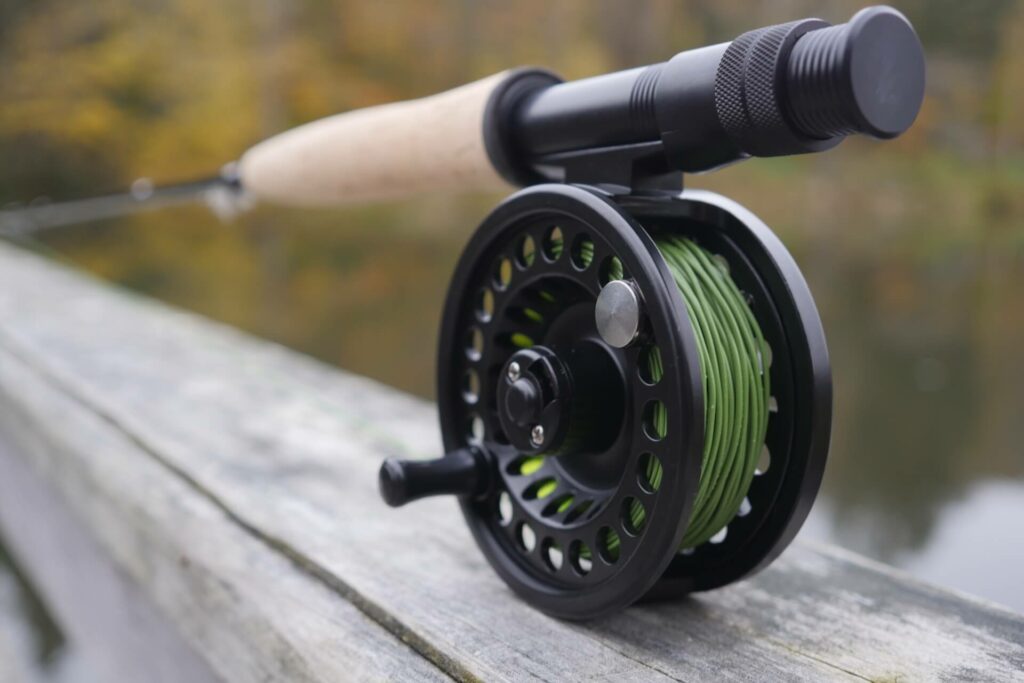
Pros:
– Excellent balance of performance and price
– Durable, lightweight graphite build
– Versatile lineup with smart design choices (fighting butts, down-locking reel seat)
– 2-year warranty for peace of mind
Cons:
– Warranty is shorter compared to some competitors’ lifetime coverage
Best Looks: Redington Classic Trout

Key Features:
– Rosewood reel seat insert for a traditional touch
– Comfortable cork handle for all-day fishing
– Moderate-fast action for both casting distance and delicate presentations
– Subtle brown blank with a classic look
I picked up the Redington Classic Trout because I wanted a rod that offered real quality without a steep price tag, and it didn’t disappoint. From the first cast, the moderate-fast action felt smooth and forgiving, giving me the ability to throw longer casts while still keeping close-range presentations soft and accurate. The cork handle is surprisingly comfortable for long sessions, and I’ve always appreciated those small touches like the rosewood reel seat and the subtle brown blank that give the rod a traditional look and feel.
What really stood out to me is how versatile it is. Whether I’m fishing dries on a smaller stream or working nymphs in a bigger river, the Classic Trout has handled it well. The four-piece build also makes it easy to pack for trips, and the titanium oxide stripping guides add just a bit more smoothness to every cast. It’s not a flashy rod, but it’s one that delivers way above its price point and is a great choice for anyone who wants something reliable without overspending.
Pros:
– Sensitive graphite blank construction
– High-quality cork handle (sourced from Portugal)
– Lifetime warranty included
– Lightweight yet strong enough for bigger fish
Cons:
– Max length is 9 ft — no 10 or 11 ft option for dedicated nymph setups
Best Action: Douglas Outdoors Era Fly Rod
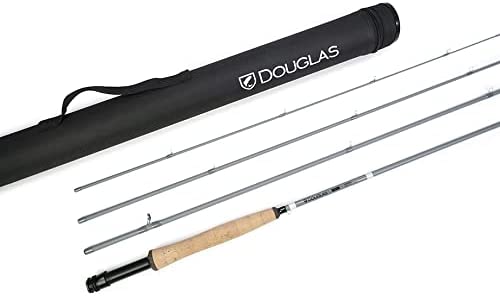
Key Features:
– Fast-action blank for easier casting timing and longer, accurate casts
– Modern light-grey finish
– Strong backbone for handling bigger fish
The Douglas Era is one of those rods that feels immediately approachable, especially if you’re new to fly fishing. I fished the 5-weight, and it struck a great balance between being forgiving for learning casts and still having the backbone to punch a line out farther when I needed it. The fast-action design (most rods are medium fast and aimed more at intermediate fly fishermen) makes the timing easier to figure out compared to slower rods, and I was pleasantly surprised by how smooth and accurate it cast, even at longer distances.
I also really like the modern look—the light-grey blank stands out without being flashy (apart from the black accents on the cork handle which I personally don’t like too much). The cork handle felt fine, though not quite as comfortable as some others in this price range, but it didn’t slow me down during a full day on the water. Paired with a good reel and line, the Era performs well beyond what I expected from a beginner-friendly rod. It’s lightweight, capable, and a great way to step into fly fishing with something that won’t hold you back.
Pros:
– Smooth, accurate casting with beginner-friendly fast action
– Modern aesthetic with light-grey blank
– Plenty of backbone for distance and power when you become more experienced
Cons:
– Limited weight options (only 4–8wt)
– Cork handle color design is not my favorite
Redington Original
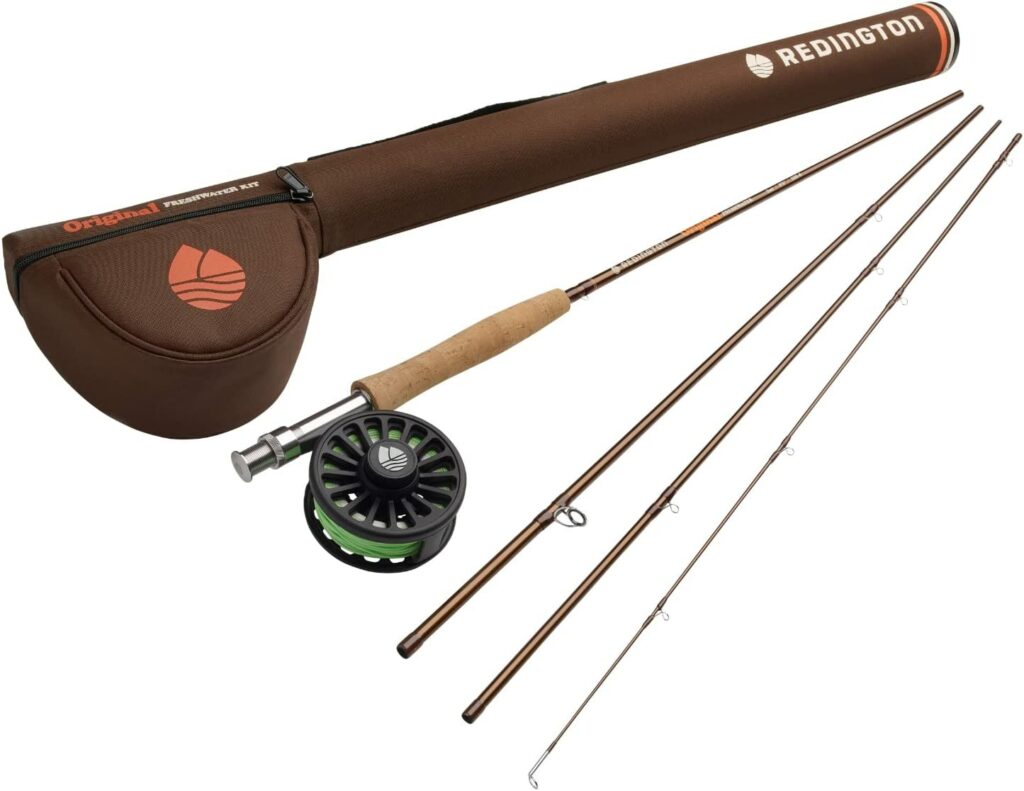
Key Features:
– Complete entry-level combo: rod, reel, and line included
– High-quality graphite rod with medium-fast action
– Available in two sizes only: 5wt (trout) and 8wt (larger species like pike or big bass)
As the last recommendation in this big guide, I want to present you my favorite fly rod combo. As mentioned above, I think a fly rod combo is great for beginners. It’s a kit that usually consists of a fly rod, a fly reel and a fly line with a leader. All you need to do is tie on a fly and you’re ready to catch fish. Redington really nailed it with the Original combo (read our in depth review here) as a true beginner-friendly setup. For $199, you get a rod, reel, and line that are ready to fish out of the box, and that makes starting fly fishing way less intimidating. The rod itself has a nice medium-fast action—easy to cast for newcomers, but with enough power to handle larger fish when you hook into one. I found the ergonomic handle comfortable even after long sessions, which isn’t always the case with entry-level gear.
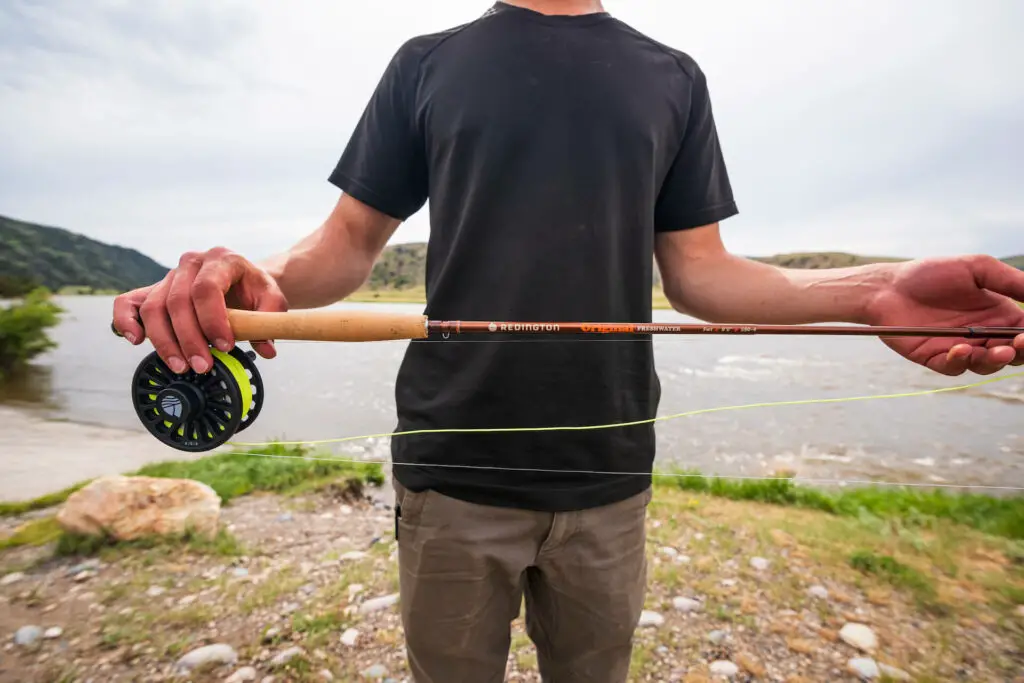
What impressed me most was the reel. The Crosswater already had a good reputation, but this updated version feels more refined, and the fact that it comes pre-spooled with backing is a huge plus. The adjustable drag gives you room to experiment with different fishing styles, from dries to nymphs to streamers, and it feels like a setup you can grow into rather than outgrow right away. For me, it’s one of the best balanced and best thought-out combos for anyone just getting into the sport.
Pros:
– Excellent value for money at $199
– Complete, ready-to-fish package (rod, reel, line, backing)
– Rio Mainstream line included
Cons:
– Doesn’t come with a leader or flies—would’ve been a perfect “ready-to-cast” kit if included
Important Features of Beginner Fly Rods
By now you know about the best fly fishing rods and combos for beginners out there on the market. If you want a little more knowledge on the important features of fly rods and reels, you’ve come to the right place. Here’s what you should pay attention to when shopping for your first fly rod (and reel).
Weight
Lightweight Fly Rods
Lightweight fly rods are ideal for beginner anglers, as they are easy to cast and handle. These rods typically range from 4-6 weight, making them perfect for small streams and rivers. The light weight of these rods also makes them great for fishing in tight spaces or around obstacles like trees or rocks. They are also well suited for smaller fish species such as trout and panfish.
Medium-Weight Fly Rods
Medium-weight fly rods offer a bit more power than lightweight models, but still maintain an easy casting action that is suitable for beginners. These rods usually range from 6-8 weight, making them better suited to larger bodies of water with bigger fish species such as bass or pike. They can be used in tighter spots too, but their heavier construction means they may not be able to make the same delicate casts that lighter models can manage.
Heavyweight fly rods provide the most power out of all the different rod weights available on the market today. These heavy duty sticks usually come in 8+ weights and are designed specifically for big game species like salmon or steelhead. While these powerful tools can certainly help you land a trophy catch, they require much more skill to use effectively due to their stiffer actions and longer lengths which make them harder to control when casting long distances into strong winds or currents.
Length
Short Fly Rods
Short fly rods are usually between 5 and 6 feet in length, making them the most compact option for beginner anglers. They are lightweight and easy to maneuver, allowing you to cast accurately even in tight spaces. This makes them ideal for fishing small streams or rivers with lots of vegetation or obstructions. However, they can be difficult to use when casting into the wind or at longer distances due to their shorter length.
Medium-Length Fly Rods
Medium-length fly rods range from 7 to 8 feet in length and offer a good balance between portability and power. These rods provide more reach than short fly rods but still remain relatively light and easy to handle. They are great for beginners who want a rod that is versatile enough for different types of fishing conditions such as larger rivers or lakes where long casts may be necessary.
Longer fly rods typically measure 9 feet or more in length and offer maximum reach when casting into the wind or at greater distances. While these longer lengths require more skill on behalf of the caster, they also allow for accurate casts with less effort due to their increased leverage over shorter models. Longer fly rods are best suited for experienced anglers who need maximum distance when targeting large fish species such as steelhead trout, salmon, pike, and musky.
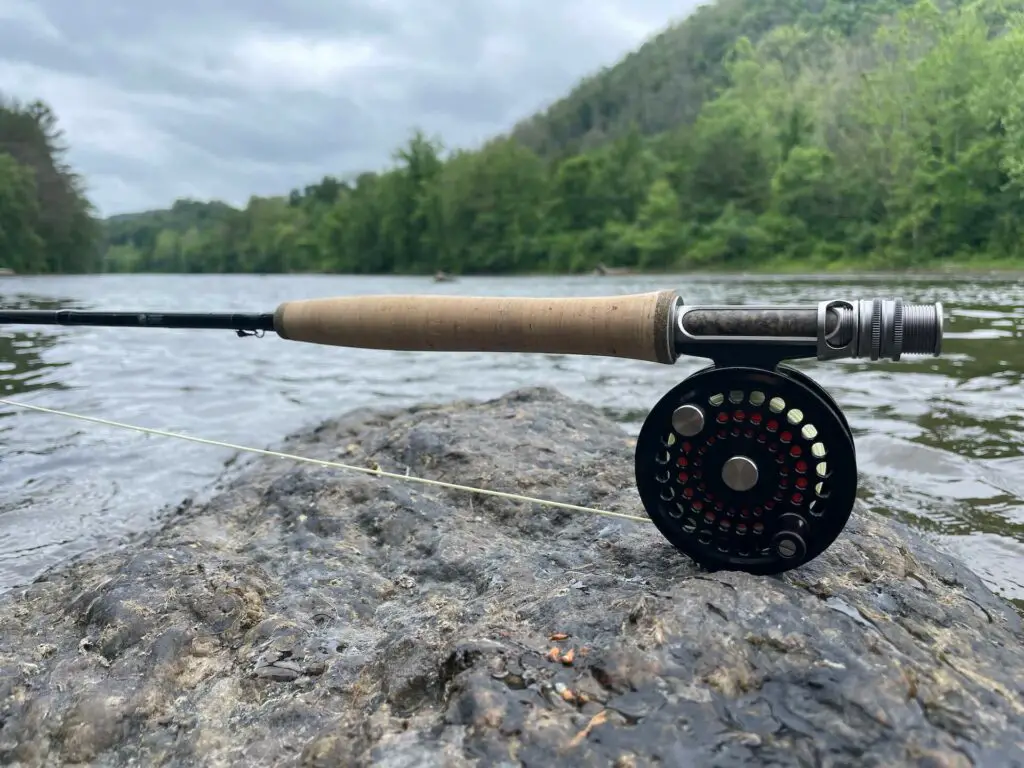
Action
Fast Action Fly Rods
Fast action fly rods are designed to be stiffer and more powerful than other types of fly rods. They provide the angler with a quick response when casting, allowing for greater accuracy and distance. These rods also have a higher line speed, which is beneficial when fishing in windy conditions or for larger fish species. The downside to fast action fly rods is that they can be difficult to control for beginner anglers who may not yet have developed their casting technique.
Moderate Action Fly Rods
Moderate action fly rods offer a good balance between power and finesse. They are generally easier to cast than fast action models, making them ideal for beginners who are still developing their skills. These rods also allow you to make delicate presentations while still providing enough backbone to fight larger fish if necessary. However, moderate action fly rods may not be as accurate or powerful as faster models when it comes to long-distance casts or windy conditions.
Slow action fly rods provide maximum feel and sensitivity when casting and retrieving lures or flies from the water’s surface, making them great options for novice anglers who want maximum feedback from their rod while learning how different techniques affect their casts and retrieves. These models also tend to be softer overall, meaning they can absorb shock better during fights with large fish species like salmon or steelhead trout without breaking the line prematurely due to excessive pressure on the rod blank itself.
Key Takeaway: Fly rods come in a variety of actions, from fast to slow, with each providing its own advantages and disadvantages. Beginners should look for a moderate action rod that offers the best balance between power and finesse for learning the sport.
Species to Target
Trout Fishing with a Beginner Fly Rod
Trout are one of the most popular species to target when starting out fly fishing. They can be found in rivers, streams, and lakes all over the world. When choosing a beginner fly rod for trout fishing, it is important to consider weight class, rod length, and action. Lightweight rods are best for small streams where accuracy is key; medium-weight rods are better suited for larger bodies of water; and heavyweight rods can handle heavier flies and bigger fish. Short rods offer more control while long rods provide more power. Fast action fly rods will help you cast further but may require more skill than slower action models which are easier to learn on but don’t cast as far or accurately.
Bass Fishing with a Beginner Fly Rod
Bass fishing with a beginner fly rod requires different considerations than trout fishing due to the size of bass compared to other species like trout or panfish. A medium-weight rod between 8-9 feet in length should be used when targeting bass as they need extra power behind them in order to land these larger fish. Fast action models work well here too since they have enough backbone to fight large bass without sacrificing accuracy or distance when casting lures into tight spots where bass often hide out during feeding times.
Key Takeaway: Fly fishing for beginners requires choosing the right rod depending on the species, with lightweight rods being ideal for small streams and medium-weight or heavyweight rods better suited for larger bodies of water. Fast action models provide more power to fight large fish without sacrificing accuracy.
Conclusion on the Best Fly Fishing Rods for Beginners
The best beginner fly rod is an important tool for any aspiring angler. It’s important to consider the weight class, rod length and action when selecting a fly rod that fits your needs. Whether you’re looking to target trout or bass, there are plenty of options available on the market in 2025. With so many choices out there, it can be difficult to decide which one is right for you. However, with careful consideration of these criteria and some research into what species you want to target, you’ll be sure to find the perfect beginner fly rod for your next fishing adventure.
Why You Should Trust Our Reviews
Leonard Schoenberger and his team spend plenty of days out fishing. Their goal is to test and review products for you so you can make a solid purchase decision and improve your fly fishing game. We always express our honest opinions, never get paid for reviews and are proud of our editorial independence.
FAQs in Relation to Best Beginner Fly Rod
What is the best length fly rod for a beginner?
A 9-foot fly rod is often recommended for beginners due to its versatility in various fishing situations.
Should I buy a 4 or 5 wt fly rod?
For beginners, a 5-weight fly rod is a good balance, offering versatility for various fish species and casting situations.
How do I choose my first fly fishing rod?
Consider factors like rod length, weight, and action. A versatile 9-foot, 5-weight rod with a moderate action is a common choice for beginners.
Is a 7-foot rod too long?
No, a 7-foot rod is not too long. It’s a suitable length for specific fishing situations, providing accuracy and control.
How much should I spend on my first fly rod?
When it comes to buying your first fly rod, there is no one-size-fits-all answer. The amount you should spend depends on several factors, such as the type of fish you plan to catch and the frequency with which you will be fishing. If you are just starting out, a mid-range rod in the $100-$200 range should provide good quality and performance for most anglers. As your skills improve, investing in higher end rods can help increase accuracy and casting distance. Ultimately, finding the right balance between cost and performance is key when selecting a fly rod that fits your needs best.
What weight fly rod is best for trout?
The best weight fly rod for trout depends on the type of fishing you are doing. Generally, a 4-weight or 5-weight rod is suitable for most trout fishing situations. A 4-weight will give you better accuracy and delicacy when casting small flies to rising fish in smaller streams, while a 5-weight provides more power and line speed when casting larger flies in windy conditions or covering large rivers. Ultimately, the choice comes down to personal preference and what works best for your particular situation.
What is the most common fly rod size?
A 9-foot fly rod is the most common size, appreciated for its versatility and suitability for various fishing environments.
Disclaimer: All products in this guide are independently researched by our team. We only recommend products we believe in and never get paid for the reviews. Learn more about our review process here.

